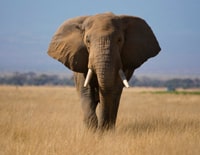Listening Practice on Elephants
Listening Practice on Elephants
You might already know that elephants are large and majestic, but the extent of their size and intelligence may surprise you. Elephants are the largest living land animal. On average, African elephants are 10 feet tall at the shoulder and weigh up to 18.000 pounds. The largest elephant in recorded history; however, was 13 feet tall and weighed about 24.000 pounds.
To sustain this massive size, an adult elephant has to consume an enormous amount up to 50 gallons of water and about 220 pounds of food, or approximately 70.000 calories every day.
Elephants’ size, however, ends up restricting their movement. While they can walk and swim, elephants are among the few mammals that can’t jump. Their legs are too slender to propel their enormous weight upward. Plus, elephants don’t have any spring in their legs since they stand on their toes.
Elephants are intelligent creatures. One sign of their intellect is their ability to recognize themselves in a mirror. The only other animals capable of doing this are humans, great apes, dolphins and magpies. Intelligence is also found in elephants’ ability to problem-solve with tools, but probably the most well-known form of elephant intelligence is their superb memory. As they migrate from place to place throughout their lives, elephants can remember locations of water sources along their migration routes.
Elephants are the only living animals with long trunks. Trunks, which are the combination of a nose and upper lip, can be heavy and powerful. They contain about 150.000 muscle units and can weigh nearly 300 pounds. While an elephant’s trunk can lift objects twice its size, it’s also adept at picking small objects.
Flap like projections on the end of a trunk are precise enough to pick up individual berries or leaves. Outside of grasping, elephants also use their trunks to greet and reassure one another. They may intertwine their trunks or touch the face of other elephants to show affection.
Elephant tusks are essential giant teeth. Much like human teeth, elephant tusks are made of a material called Dentin. The major difference is that elephant dentin has a diamond pattern that makes it super strong and gives it luster. Young elephants even go through a set of baby teeth, but theirs include baby tusks. They fall out after about a year and replaced with a permanent set that can grow six feet long and weigh 50 pounds each.
Unfortunately, elephants have been illegally hunted for their tusks. Demand for ivory products, which are made from tusks, has caused elephant population to decline. African elephants are not endangered, but their Asian cousins are. African elephants are listed as vulnerable, and some countries in Southern Africa are even experiencing an overpopulation of African elephants.
Asian elephant populations have decreased immensely. The species habitat, once stretched across Asia from Syria to Northern China, but today they only exist in isolated pockets between India and Indonesia. Habitat fragmentation, poaching for ivory, and conflict with local farmers are all factors that put elephant populations at risk.
But by studying the complicated nature of conservation, we can come closer to finding a way that both people and elephants, with their exceptional intelligence and larger than life presence, can peacefully coexist.




Hi Dr.Hariri. I have a few question. What is the meaning of this phrase:
( larger than life presence)
and this sentence: (Flap like projections on the end of a trunk are precise enough to pick up individual berries or leaves. )
Hi Armaghan. Thank you for using this comment to ask us your questions.
About your first question, exceptional intelligence refers to people or humans, and larger than life presence refers to huge size of elephants, and the possibility of living together peacefully. Larger than life presence means mammoth quality.
And about your second question, it refers to the loose and thin layer of muscle that sticks out of an elephant’s trunk designed specifically for picking up tiny things like berries and leaves on the ground.
Berries like: strawberry, blueberry, blackberry, raspberry, etc.
Projection: end part of something that sticks out or protrudes.
Flap like = the thin muscle at the end of the trunk, which is so flexible.